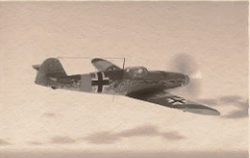The Messerschmitt Bf 109 F-4 «Frederich» was a German fighter in service with the Luftwaffe used primarily as a fighter and high altitude interceptor. A Tier 2 aircraft, the Bf 109 F-4 has an upfront cost of 90000 ![]() .
.
Design, Development, & History[]
It was one of the first truly modern fighters of the era, including such features as all-metal monocoque construction, a closed canopy, a retractable landing gear, and was powered by a liquid-cooled, inverted-V12 aero engine.
The Bf 109 first saw operational service during the Spanish Civil War and was still in service at the dawn of the jet age at the end of World War II, during which time it was the backbone of the Luftwaffe's fighter force. From the end of 1941 the Bf 109 was supplemented by the Focke-Wulf Fw 190.
Originally conceived as an interceptor, later models were developed to fulfill multiple tasks, serving as bomber escort, fighter-bomber, day-, night-, all-weather fighter, ground-attack aircraft, and as reconnaissance aircraft. It was supplied to and operated by several states during World War II, and served with several countries for many years after the war. The Bf 109 was the most produced fighter aircraft in history, with a total of 33,984 units produced from 1936 up to April 1945.
The Bf 109 was flown by the three top-scoring German fighter aces of World War II, who claimed 928 victories among them while flying with Jagdgeschwader 52, mainly on the Eastern Front, as well as by Hans-Joachim Marseille, the highest scoring German ace in the North African Campaign. It was also flown by several other aces from Germany's allies, notably Finn Ilmari Juutilainen, the highest scoring non-German ace, and pilots from Italy, Romania, Croatia, Bulgaria and Hungary. Through constant development, the Bf 109 remained competitive with the latest Allied fighter aircraft until the end of the war.
The Bf.109-F variant, or «Friedrich», was a replacement for the Emil. Friedrich reached front-line units in the Autumn of 1941 and, by the middle of the following year, almost two-thirds of Luftwaffe fighter regiments were equipped with the variant.
Skins[]
F-2 III JG 53 Channel Front: Shoot down 100 players

F-2 III JG 53
I/JG 54 of Cpt Hans Phillip Kransnogvardeisk 1942: Shoot down 130 players

I/JG 54
9/JG 52 of Lt Hermann Graf Kharkov-Rogan 1942: Shoot down 150 players
III/JG 5 Finland 1942: Shoot down 180 players
7/JG 54 Cpl Gerhard Raimann Siverskaya 1942: Shoot down 200 players
